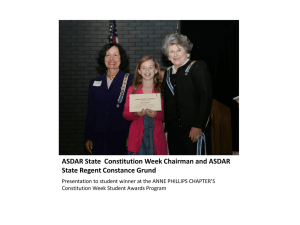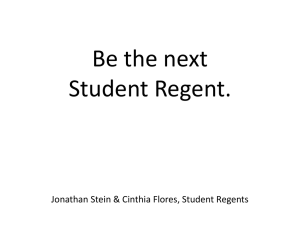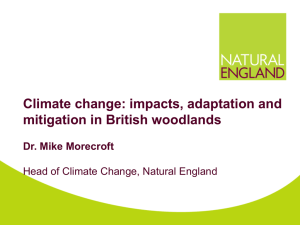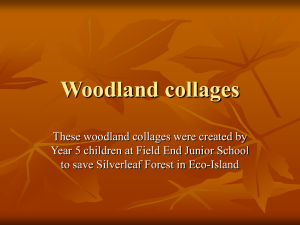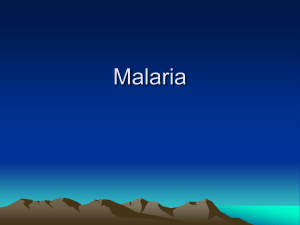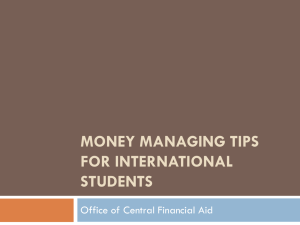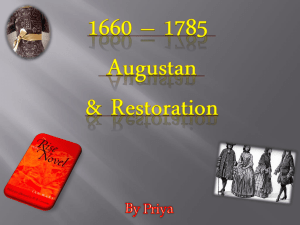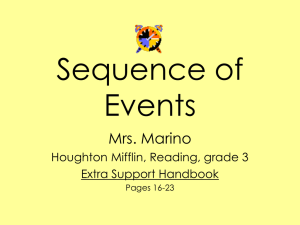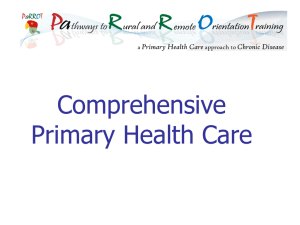Swifty-Regents powerpoint presentation
advertisement
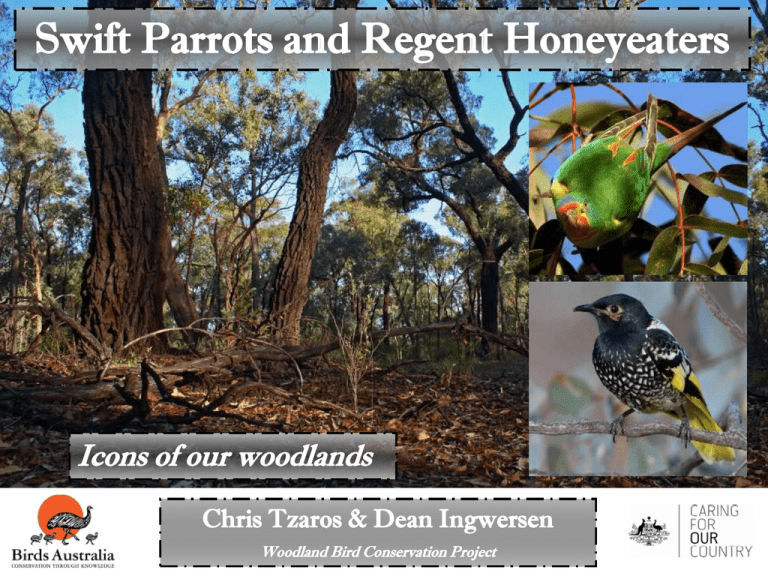
Swift Parrots and Regent Honeyeaters Icons of our woodlands Chris Tzaros & Dean Ingwersen Woodland Bird Conservation Project Woodland Bird Conservation Project background • • • • • Swift Parrot/Regent Honeyeater funding crisis Current phase based on Commonwealth Recovery Plan implementation for swifties and regents Initiate other projects targeting declining and threatened species - research - monitoring - on-ground restoration - knowledge brokering Plan is to work with project partners in Vic. (Trust for Nature), Tas. (Tas Land Conservancy) and NSW (Nature Conservation Trust) Emphasis on private woodland conservation such as strategic covenanting 2 Need for this project • • • • • One third of Australia’s woodlands are cleared 80% of temperate woodlands have been lost Over a third of Australia’s land birds are woodland dependant One in five of these is listed as ‘threatened’ (over 40 species) Birds of south-east temperate woodlands have suffered most 3 Introducing the Swift Parrot 4 Distribution • • Widespread across the temperate south-eastern woodlands, including Tasmania where it breeds Migrates across Bass Strait for autumn-winter (longest migrating parrot in the World) Non-Breeding Breeding 5 Movements October – December: • Breeding • Eastern Tasmania in Blue Gum forest January: • First year birds are mobile • Disperse through central and northern Tasmania Non-Breeding Breeding 6 Movements February - April: • Arrive on mainland May - August: • Nomadic throughout central, southern and north-east Vic, NSW south, central and north coast, south-west and central slopes, occasionally south-east Qld Non-Breeding Breeding 7 Movements September: • Southward migration Non-Breeding Breeding 8 Abundance • Population: 1987 - 1320 breeding pairs 1995 - 940 breeding pairs • “Swift Parrot population estimated to be no more than 1000 breeding pairs” Swift Parrot Recovery Plan 2001 • Conservation status: Endangered Nationally (listed under Commonwealth EPBC Act 1999) 9 Introducing the Regent Honeyeater 10 Distribution 11 Movements • Highly mobile but appear to have regular patterns of movement • Late summer-winter - disperse widely in small groups • Late winter-spring - concentrate back into core breeding areas: • Capertee Valley, central NSW • Bundarra - Barraba, northern NSW • Chiltern, Vic 12 Changes in abundance • Contraction in range (from SA, western Victoria and parts of Qld) • Reporting rates have declined and flocks observed are smaller - until early this century the Regent Honeyeater congregated from time to time in large flocks, described enthusiastically as containing “immense numbers” (1866) and “thousands” (1909). • Very difficult to estimate current numbers: • Reporting rate is very low for a species that inhabits a largely agricultural landscape 13 Threats • Loss of habitat and reduction in quality (particularly fragmentation) • Clearing for agriculture • Forestry and cutting for firewood • Continuing decline of trees in agricultural landscape • Lack of regeneration • Competition with other large nectar feeders for patchy and unpredictable resources • Climate change and drought 14 ‘Flagships’ for woodland conservation • Actions to reverse the declines of these two high profile species will have flowon benefits to a host of other threatened and declining woodland birds 15 Jacky Winter • Insectivorous • Ground and trunk foraging • Favours slightly open areas 16 Brown Treecreeper • Insectivorous • Ground and trunk foraging • Hollow breeder 17 Diamond Firetail • Granivorous • Ground foraging • Dependant on healthy grassy woodlands 18 Speckled Warbler • Insectivorous • Ground foraging • Often in mixed-species foraging flocks 19 Habitat in Victoria • • • • Box-ironbark forests and woodlands Lowland vegetation communities on fertile sites are preferred These sites have important drought refuge characteristics Trees at such sites flower more frequently and abundantly 20 Forage trees in Victoria Grey Box Eucalyptus microcarpa Early autumn flowering White Box Eucalyptus albens Mid-late winter flowering Yellow Gum Eucalyptus leucoxylon Mid-late winter flowering, abundant nectar, good lerp loads Red Ironbark Eucalyptus tricarpa Mid-late winter flowering, abundant nectar but severely drought affected Red Box Eucalyptus polyanthemos Occasional lerp infestation Yellow Box Eucalyptus melliodora Late spring-early summer flowering, occasional lerp loads, good for insects River Red Gum Eucalyptus camaldulensis Reliably harbours insects and Golden Wattle Acacia pycnantha regular lerp loads Racemes in winter important for swifties 21 Identifying the Swift Parrot 22 Identifying the Swift Parrot Purple-crowned Lorikeet LittleLorikeet • Plumage differences include: - Red under wings and tail Musk Lorikeet Scaly-breasted Lorikeet Rainbow Lorikeet 23 Identifying the Swift Parrot • Similar species and calls Little Lorikeet Purple-crowned Lorikeet Musk Lorikeet Swift Parrot 24 Identifying the Regent Honeyeater 25 Identifying the Regent Honeyeater Other ‘yellow-winged’ honeyeaters: • New Holland HE smaller and have white on face • Painted HE white underparts and pink bill • White-fronted and Crescent very rare • Note that field guides incorrectly illustrate a pink or red face 26 Identifying the Regent Honeyeater • Similar species and calls New Holland Honeyeater Regent Honeyeater Painted Honeyeater 27 Swiftie and Regent surveys • • • The winter surveys were set up to track these highly mobile creatures They have been successful in telling us a great deal There is still much to be learned by continuing them 28 Swiftie and Regent surveys • • A good way to cover lots of ground is to drive through suitable habitat listening for bird activity Upon finding a good patch, stop and survey/wander the area looking and listening for the target species 29 Woodland Bird Surveys • • 20 min x 2 Ha transect 500m area search - these are often the best methods for locating threatened and cryptic species, like Swifties and Regents 30 Swiftie and Regent surveys Traditional survey dates: • 3rd week of May (this year, 16-17 May) • 1st week of August (this year, 1-2 August) However, we also seek opportunistic information outside these periods necessary 31 The survey sheet 32 The survey sheet 33 Other activities to assist Swifties and Regents • Lurg revegetation project Ray Thomas Phone: (03) 57 611 515 Fax: (03) 57 611 628 email: raydavidthomas@hotmail.com Web: regent.org.au 8-9 August 22-23 August 5-6 September 19-20 September 34 Contact: Chris Tzaros & Dean Ingwersen Woodland Bird Conservation Project c.tzaros@birdsaustralia.com.au d.ingwersen@birdsaustralia.com.au (03) 9347 0757 For more information, visit: www.birdsaustralia.com.au/wbc 35
